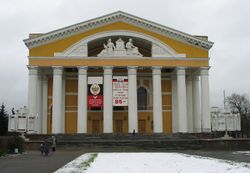Yoshkar-Ola
| Yoshkar-Ola (English) Йошкар-Ола (Russian) Йошкар-Ола (Mari) |
|
|---|---|
| — Inhabited locality — | |
 National theatre of the Mari El |
|
 Yoshkar-Ola
|
|
| Coordinates: | |
_(2005).png) |
.png) |
| Holiday | 3rd Saturday in August |
| Administrative status | |
| Country | Russia |
| Federal subject | Republic of Mari El |
| Capital of | Mari El |
| Municipal status | |
| Urban okrug | Yoshkar-Ola Urban Okrug |
| Head | Oleg Pavlovich Voinov |
| Representative body | City Duma |
| Statistics | |
| Area | 101.45 km2 (39.17 sq mi) |
| Population (2002 Census) | 281,165 inhabitants[1] |
| - Rank | 74th |
| - Density | 2,771 /km2 (7,180 /sq mi)[2] |
| Time zone | |
| Founded | 1584 |
| Postal code(s) | 655000 |
| Dialing code(s) | +7 +7 3902 |
| Official website | |

Yoshkar-Ola (Mari and Russian: Йошка́р-Ола́) is a city in Russia and is the capital of the Mari El Republic. It has a population of 281,165 (2002 Census), which is slowly increasing as people from neighboring areas move to the city.
Yoshkar-Ola means red city in Mari. The current name is the third to have been given to the city. The city was known as Tsaryovokokshaysk (Russian: Царёвококшайск) before 1919 and as Krasnokokshaisk (Russian: Краснококшайск) between the years of 1919 and 1927. These names were derived from the river Small Kokshaga, which runs through the city.
During the Soviet era, especially post-WWII, the city was a regional industrial and transport center and grew to its current size. The collapse of the Soviet Union removed support for state enterprises, and led to the shutdown of most manufacturing activity in the area. Much of the city's economic activity was supported by shuttle traders who would transport (often counterfeit) goods from the bustling markets of Moscow to Yoshkar-Ola's bazaars. The sharp decline in living standards led to the emigration of specialized professionals to larger cities in Russia.
A Strategic Rocket Forces base is located nearby.
Contents |
Transportation
Yoshkar-Ola is linked to other cities and regions in Russia by a series of train and bus routes. The local train station is currently served by a daily train to and from the capital Moscow with other short-service trains running to and from Kazan. Moscow and various other nearby towns and regions can also be reached by buses departing from the local bus station. The Yoshkar-Ola Airport is also located 9 km north of the city and handles small aircraft Moscow-bound flights (Domodedovo International Airport) since June 2008. It is planned to expand the range of destinations in the near future.
Destinations within the city limits can be reached through a network of buses, trolleys, and route taxis, or marshrutkas. There are currently seven different bus routes, eleven different trolley routes, and seventeen marshrutka routes.
Climate
The city is situated in a temperate continental climate. The winters are long and cold with high yearly snowfall totals in these regions, in the majority of winter seasons a temperature of -18°C or lower can be expected with January as the coldest month. The area enjoys pleasantly warm summers, marred by only occasional, brief intervals of sultry or rainy conditions with July as the hottest month (+22...+24°C).
Education
Yoshkar-Ola is home to several institutions of higher education:
- Mari State University (Марийский государственный университет)
- Mari State Technical University (Марийский государственный технический университет)
- Mari State Pedagogical Institute (Марийский государственный педагогический институт) (incorporated into Mari State University in 2008)
Yoshkar-Ola's twin towns
Yoshkar-Ola is twinned with:
See also
External links
- Detailed map of the city of Yoshkar-Ola
- Yoshkar-Ola in Mari El
- Yoshkar-Ola city photos
- Red-White Yoshkar-Ola RUS
- Yoshkar-Ola travel guide from Wikitravel
References
- ↑ Федеральная служба государственной статистики (Federal State Statistics Service) (2004-05-21). "Численность населения России, субъектов Российской Федерации в составе федеральных округов, районов, городских поселений, сельских населённых пунктов – районных центров и сельских населённых пунктов с населением 3 тысячи и более человек (Population of Russia, its federal districts, federal subjects, districts, urban localities, rural localities—administrative centers, and rural localities with population of over 3,000)" (in Russian). Всероссийская перепись населения 2002 года (All-Russia Population Census of 2002). Federal State Statistics Service. http://perepis2002.ru/ct/html/TOM_01_04_1.htm. Retrieved 2009-08-19.
- ↑ The value of density was calculated automatically by dividing the 2002 Census population by the area specified in the infobox. Please note that this value may not be accurate as the area specified in the infobox does not necessarily correspond to the area of the entity proper or is reported for the same year as the Census (2002).
|
|||||||||||||||||
|
|||||